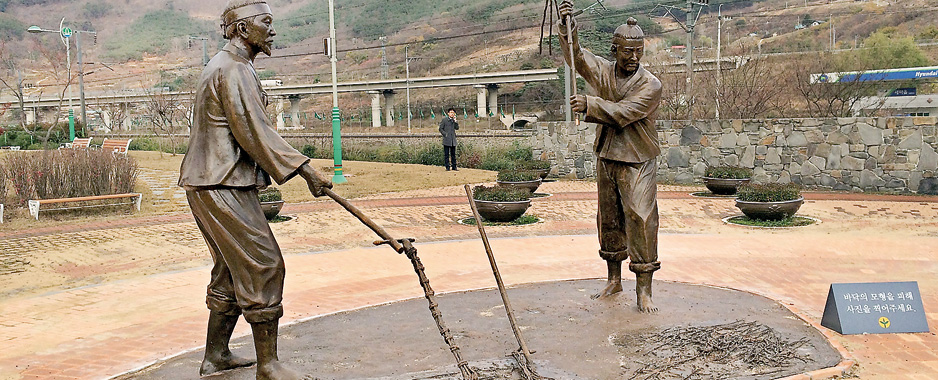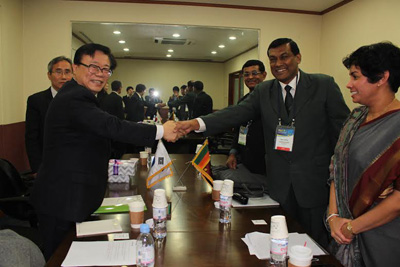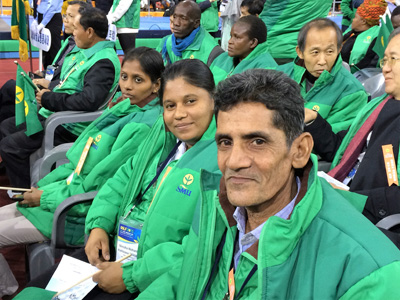Sunday Times 2
Spreading the message of Saemaul Undong
A land cutting edge technology, of a capital city that some say rivals New York for its dazzle and dynamism, a gentle yet diligent people – South Korea as we know it is one of Asia’s great success stories.
It wasn’t always so though. A generation that grew up fifty years ago in the aftermath of the Korean War can recall a time when it was one of the region’s poorest, a country where starvation stalked villages and hope was a commodity in scarce supply.
So what changed? A grassroots movement that inspired a nation, driven by the people and fuelled by three strictly commonsense tenets – diligence, self-help and co-operation is now being hailed as one that contributed greatly to the country’s prosperity. That movement that had been quietly transforming the little village of Sing-do was soon picked up by the rest of the nation and a rural revolution began. The statistics are eloquent proof: South Korea’s dramatic progress saw its Per Capita Income going from 79 USD in 1960 to 27,970 USD in 2014.
It was South Korean President Park Chung-Hee who on his way back by train after visiting flood-stricken areas spied the village of Sin-do, in Gyeongsang North Province in July 1969 and was immediately struck by its appearance – boundary walls built of stone and neat tiled roofs in a landscape where other villages were just a mass of haphazardly constructed dwellings with thatched roofs. Intrigued, the President ordered the train to be stopped and stepped out to see for himself what was behind this.
It was a simple story of collective participatory effort by the villagers. So impressed was he by that model of community development that in 1970, President Park spearheaded the movement known as Saemaul Undong (New Village Movement) that would lead rural communities to self-sufficiency and prosperity, urging that every village in Korea should be like Sin-do. The government acted on his words, supplying every one of the nation’s 33,267 villages with 335 bags of cement and 0.5 tons of iron rods in their drive to boost development.
The efforts to power community-led development worked. Women stepped forward to join men in improving their villages and some 16,600 villages were able to show significant progress in enhancing incomes. Competition among villages to forge ahead played its part. Rural infrastructure was drastically improved and the rural and urban divide suddenly no longer seemed insurmountable with villagers enjoying better standards of living.

Working together: A monument to Korean villagers on the premises of the Sing-do Memorial Hall
Today South Korea believes it is time to share the lessons of the Saemaul Undong Movement’s success with the world. And so it was that over 500 delegates from some 50 countries gathered in the city of Daegu (South Korea’s third largest) from November 24-27 for the Global Saemaul Leadership Forum (GSLF). The Saemaul Undong leaders from across Korea, were joined by representatives from countries in Asia, Africa and Latin America who have adopted and adapted its model of transformative community leadership back home and the Congress Hall at the Inter-Burgo Hotel was a colourfully vibrant picture of cultures coming together – African robes and Asian sarees, lungis and turbans happily mingling with the Saemaul jackets of forest green.
As the flags of the participating countries were brought into the hall on the morning of November 24 signalling the start of the Global Saemaul Leadership Forum with its theme of ‘Sustainable Development with Saemaul Undong’, it was a rallying call for progress in the future. The GSLF was hosted by the Korean Ministry of the Interior and organised by the Korea Saemaul Undong Center along with the Daegu Metropolitan City with sponsors being the Ministry of Foreign Affairs, Ministry of Agriculture, Food and Rural Affairs, Rural Development Administration, Gyeongsangbuk-do and KOICA.
In her video message to the conference, Korean President Park Geun-hye spoke of how the Saemaul Undong movement had grown into “a sustainable development paradigm – one that is looked up to by the international Community including the UN” and reiterated her government’s commitment to make it an international model for regional development.
The keynote speaker that morning was renowned economist, Prof. Jeffrey D. Sachs who emphasised the ‘can do’ spirit of Saemaul Undong. Eminently equipped to comment on South Korea’s amazing transformation for he had been coming to the country for all of 30 years, Sachs said, “Korea is a proof of what can be accomplished.”
Reminding his audience that on September 25th, the 193 UN member states had adopted the Sustainable Development Goals for 2016 -2030, Sachs who is Special Advisor to UN Secretary General Ban Ki-moon and Director of the UN Sustainable Development Solutions Network said, “We’re here because we know Saemaul Undong can be a enormous force towards achieving these goals.”
The concept of SDGs is that we should provide three objectives in our society – economic development including the end of poverty; social inclusion including gender equality, the observance of human rights; and environmental sustainability, Sachs noted.
“This is a country in which almost everybody was poor in 1960 and which has eliminated extreme poverty completely within this half-century… We should thank Korea for sharing these successes with us.” Can SDG 1, which is to end extreme poverty be achieved, he asked, adding that yes, it’s very difficult, but it can be done. If a country is lucky enough to have internal peace, strong development efforts, openness to the world – to technology, to education and good partnerships with Korea to make this advance, it can end extreme poverty.
Sachs spoke of the New Village movement’s community-based development, fitting in with the larger picture, which, he said, “Korea has mastered so magnificently”. Together with Saemaul Undong came a major effort at industrialization, technological advancement, a world class education system and quality infrastructure. It focused on rural development in the context of national development. It’s not the whole story but a crucial component of what needs to be done. And Governments need to think holistically. Korea’s success is that it was focused on industrialization, agricultural improvement and educational improvement. We need to move on many fronts together for success – make an integrated strategy, he said.
Among the countries represented in the hall from Myanmar to Mongolia, Honduras and Azerbaijan, Rwanda and Ethiopia was Sri Lanka, with a delegation comprising both senior state officials and Saemaul Undong village leaders.
Speaking to the Sunday Times in between rounds of meetings with senior Korean officials including Korea’s Interior Minister, State Minister for Agriculture Wasantha Aluwihare who was leading the Sri Lankan delegation was full of enthusiasm for Saemaul Undong, stressing that modern technology would be helpful to the country’s farmers in line with the Government’s three-year plan to improve agriculture and productivity. “We have learnt something from here and are hoping to expand the projects already begun further,” he said, optimistic that new projects could be started in the North as well.
Sri Lanka had had its own version of this rural community development effort in the Sarvodaya movement spearheaded by Prof. A.T. Ariyaratne and the shramadana campaigns of the 70s, the State Minister who was leading the Sri Lanka delegation said. Minister of Primary Industries Daya Gamage had been scheduled to make the trip to Daegu had been unable to come due to pressing matters.
Continuing education is a prime focus of the programme, with Saemaul leaders from all over the world being trained at the Global Saemaul Undong Training Center in Seoul. Four officials from the Sabaragamuwa Provincial Council were also attending the conference and then staying on to learn in detail the concepts and strategies that underlie the Saemaul thinking so that they in turn could train others.
The Daegu Declaration adopted on the second day of the conference called for greater leadership from the Korean government in sharing Korea’s experience with other developing countries and urged the UN to use Saemaul Undong to achieve its SDGs. Points of interest were encouraging women’s participation and establishing co-operative structures between central and local governments.
Significantly, the Saemaul Undong Movement has now been recognized by organizations like the United Nations Development Programme (UNDP), the World Food Programme (WFP) and the Economic and Social Commission for Asia and the Pacific ( ESCAP) as a model for poverty eradication.
In June 2013, UNESCO listed the archives of the Saemaul Undong from the 1970s on its Memory of the World Register, with its International Advisory Committee stating that ” the movement became the cornerstone of Korea’s rapid growth from a poor country to one of the world’s top ten economic powers and a precious asset to the history of mankind”.

High-level meetings: Sri Lanka's State Minister for Agriculture Wasantha Aluwihare meeting the Korean Minister for Agriculture, Food and Rural Affairs Lee Dong-Phil. Also in the picture are Sri Lanka's Ambassador to Korea, Manisha Gunasekera and Additional Secretary, Ministry of Agriculture J.D.H. Wijewardena - Pic courtesy Sri Lankan embassy in Seoul
On the final day of sessions, foreign journalists attending the GSLF were taken to the Sing-do Memorial Hall, an hour’s drive from Daegu in Cheongdo. This was the birthplace of the Movement and at the museum visitors can listen to videos and view pictorial depictions of the journey of South Korea’s impoverished farming villages to model townships.
Outside with the frosty winds blowing, there is a little village to see – built to show what life in Singdo must have been like as Saemaul Undong took root. A replica of the Presidential train that President Park Chung-Hee had alighted from at the station stands in pristine condition and farmers’ cottages, one with a rice mill, another with large earthen jars in the yard for making kimchi, that quintessentially Korean dish of pickled cabbage and other vegetables, bring the past vividly back.
The stark landscape around tells of the approaching winter – yet a solitary persimmon tree, bare of leaves bearing abundant golden fruit seems to signify this tale of growth against all odds.
| How Saemaul Undong works Built on the vision of community participation through the key principles of diligence, self-help and co-operation, the Saemaul Undong or New Village Movement saw the development of rural areas through improving their basic infrastructure -access roads, housing, irrigation and drainage and empowering villagers to play a role in their own progress, lessening their reliance on government funding, instead looking to use community resources. Initially help came from the government in the form of raw materials such as cement which the villagers could use to build whatever they chose.Villagers were encouraged to identify income-increasing projects and improve agricultural productivity. Most significant in the Saemaul philosophy was the change in mindset that nurtured the will to change their own lives and that of their communities. Training was provided for village leaders to ensure lasting and sustainable change. As South Korea’s technological miracle took shape, the Saemaul Undong Movement ensured villages also benefited and with education and empowerment, would not be left behind. The results were startling: average rural income that was only 67 per cent of that of an urban worker in 1970 had within four years outstripped the latter. | |
 All the way from Lanka: (from left): Saemaul village leaders K.G. Priyangani Kumari, H.P.G. Nirosha Nishanthi and A.G. Ranasinghe at the Saemaul Leaders Convention Sri Lanka and Saemaul Undong There are as many as seven Saemaul Undong projects currently underway in Sri Lanka helping villagers towards a sustainable future. In Epitawatta in the Ratnapura District, the changes have been in practical measures. Not merely in the quantum of aid flowing in, but help that would impact on people’s day-to-day lives: concreting the roads to the village, the construction of a community hall, the supply of three phase electricity. In Kahambiliyagoda, a village in the Kegalle District, there is help through modern technology – powered pottery wheels making it possible for women to take to this traditional industry where earlier the effort needed to turn the wheel made it hard for them to handle. “Production doubled and average income increased by more than four times,” Advisor to the Ministry of Primary Industries, Aruna Kulatunga told the case study workshop at the Global Saemaul Undong Forum, echoing the Government’s vision to create one million new jobs by 2020. “Clear results indicate that the Saemaul Undong concept has validity and traction in Sri Lanka.” ointing out that historically the fact that there are cultural similarities in the way collective decisions are taken at village level, he said the attitudinal change required to put Saemaul Undong concepts into practice was thus eased but there remained the need for strong monitoring and feedback mechanisms. |

